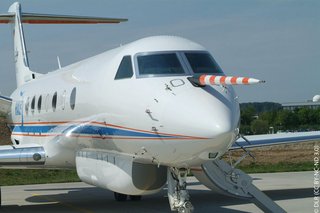The research aircraft HALO, which performs complex measurements in the atmosphere at high altitudes, receives further funding by the German Research Foundation (DFG). The share allocated to the University of Cologne for the development of new instrumentation technology amounts to around 3 million euros. The High Altitude and LOng range research aircraft, or HALO for short, has been providing unique services for Earth system research for over a decade. In addition, the high-altitude research aircraft represents international scientific cooperation with its worldwide measurement campaigns when it comes to key questions about atmospheric processes and their global impact on the climate. Dr Mario Mech and Professor Dr Susanne Crewell have successfully acquired the extension of the technical instrumentation of the ‘high flyer’ for the University of Cologne.
Equipped with state-of-the-art sensor technology, HALO makes a significant contribution to research into global environmental issues. The University of Cologne appliance development is part of a large-scale device initiative of the DFG to significantly expand the scientific payload. The funding period begins in January 2024 for 5 years. In addition to the University of Cologne, the universities of Frankfurt, Hamburg and Leipzig are also involved in projects.
Flying high-tech laboratory explores the Earth system
HALO is not just an aircraft, but a flying high-tech laboratory that opens up new perspectives on the exploration of the Earth system. Since its first test flight in 2009, it has been taking off regularly not only to explore the atmosphere and properties of the Earth's surface, but above all to deepen our understanding of our planet and to jointly shape a sustainable future while considering climate change. The aircraft-based measuring platform is not only equipped with exceptional flight characteristics (maximum range = 8,000 kilometres, instrumental payload = up to 3 tons, maximum altitude = 15 kilometres), but also features complex and highly specialized in-situ and remote sensing instrumentation.
Technical innovations enable new research ideas
In order to make the best use of HALO, existing instruments must be continuously optimized and new, innovative devices must be constantly integrated into the scientific equipment of the aircraft. The DFG funding allows universities to develop and certify additional instruments for HALO. This will enable the implementation of research ideas in future missions. The University of Cologne contribution includes a cutting-edge submillimeter radiometer (HALO Microwave Package next generation – SubMillimeter Radiometer, HAMPng-SMR for short), which will provide the opportunity to carry out measurements in completely new frequency ranges that have hardly been probed so far. This will significantly extend and improve HALO’s ability to observe clouds, precipitation and water vapour. A key aspect in the development of HAMPng-SMR is the use of frequencies and measurement principles of future satellite missions, such as that of the Ice Cloud Imager (ICI) on MetOp-Second Generation (MetOp-SG), which will start operating in 2025. This makes it possible to check satellite observations and to further develop methods for deriving cloud and precipitation properties as well as water vapour. The first missions in which HAMPng-SMR will be part of HALO instrumentation are planned for 2028.
Solutions for climate change: looking into the future
The detailed HALO observations will contribute to a better understanding of the processes in the atmosphere and the Earth system. They also support the interpretation of the next generation of satellite missions, which provide global insights into the changing climate system. The new instrumentation is in line with the Cologne Key Profile Area ‘Intelligent Methods for Earth System Sciences’ and the joint ‘Center for Earth System Observation and Computational Analysis’ of the Universities of Bonn and Cologne and Forschungszentrum Jülich.
Media Contact:
Dr Mario Mech
+49 221 470 1776
mario.mechuni-koeln.de
Press and Communications Team:
Jan Voelkel
+49 221 470 2356
j.voelkelverw.uni-koeln.de
Further information:
